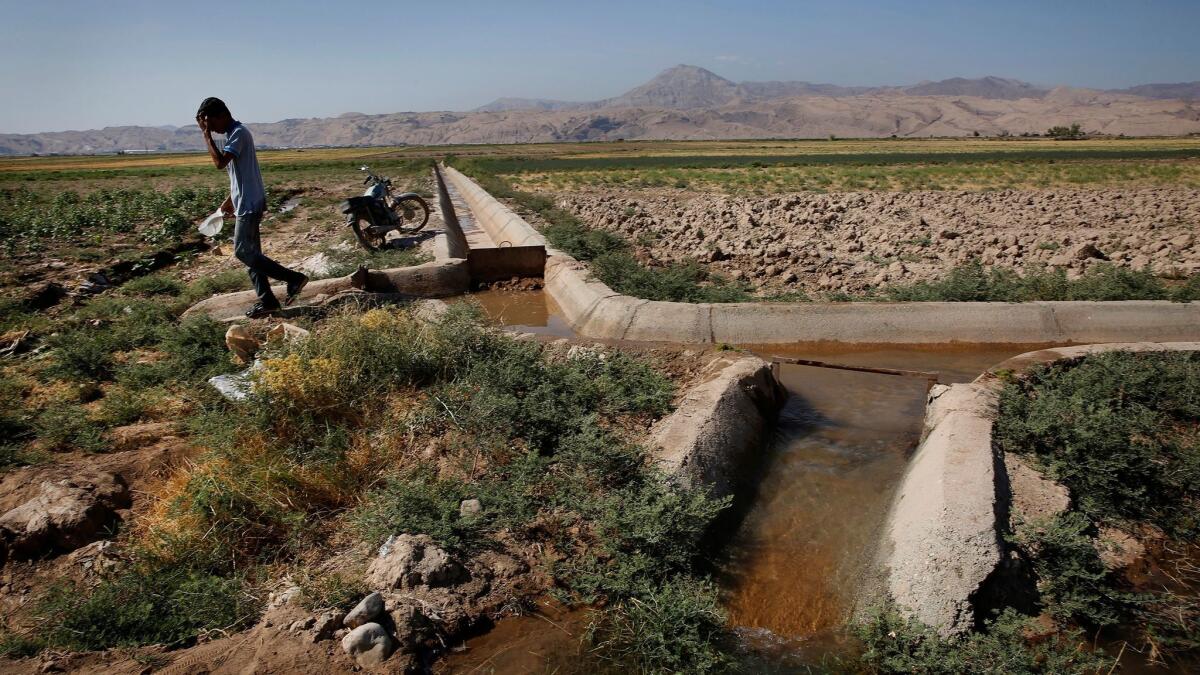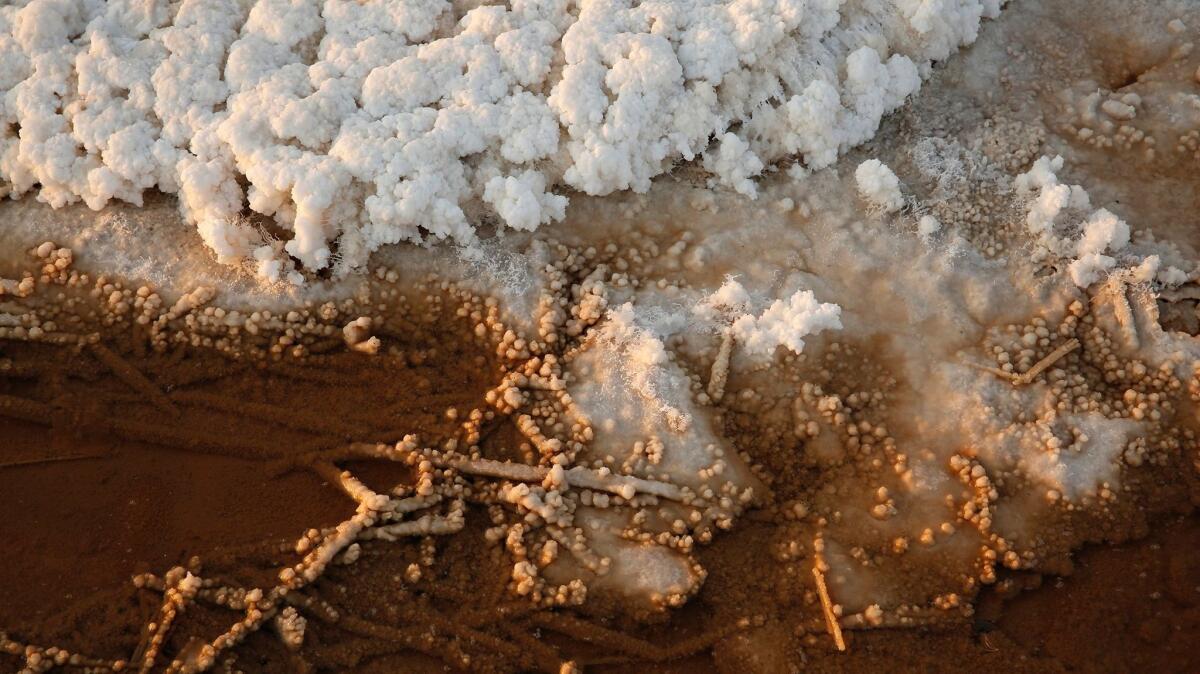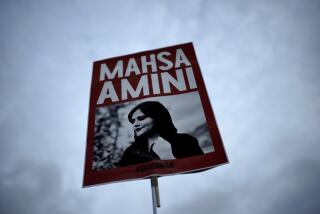A long-simmering factor in Iran protests: climate change

- Share via
Reporting from Tehran — In the mountains of western Iran, the province of Chaharmahal-Bakhtiari is known for mile-high lagoons, flowing rivers and wetlands that attract thousands of species of migratory birds.
But years of diminishing rainfall have shriveled water sources. Conditions worsened, residents say, after Iranian authorities began funneling water 60 miles away to the lowland city of Esfahan, sparking protests as far back as 2014.
On Dec. 30 of last year, about 200 people gathered in front of the provincial governor’s office to protest the water transfer project. Their slogans soon morphed into chants of “Death to the dictator,” the main rallying cry of anti-government protesters who poured into streets nationwide in the biggest spasm of public anger Iran has seen in years.
The uprising — in which at least 21 people died and thousands were arrested before authorities reimposed order — had many sparks: rising prices, persistent unemployment, bank collapses, a wide wealth gap, corruption in the theocracy.
But an overlooked factor, analysts say, is the impact of climate change and the widespread perception that Iran’s leaders are mishandling a growing problem of water scarcity.
“People believe that this is yet another major crisis the country is facing, and the people at the top are too incompetent and too corrupt to care,” said Meir Javedanfar, a professor of Iranian politics at Interdisciplinary Center Herzliya, an Israeli university.
“It does not seem to be a priority of the regime to address the drought issue,” he said. “As long as it’s not a priority, nothing will happen until something breaks.”
Many environmental activists believe Iran is quickly approaching its breaking point as diminishing rainfall and warmer temperatures have caused lakes to disappear, kicked up blinding dust storms and emptied out once fertile regions as farmers seek economic refuge in cities.
Drought is a concern across the Middle East, but Iran’s 80 million people are especially at risk. This month, the director of Iran’s Drought and Crisis Management Center, Shahrokh Fateh, said that 96% of the country’s land area was experiencing prolonged drought conditions, the semiofficial ISNA news agency reported.
In some of the hardest hit areas, including border provinces where ethnic and religious minorities complain of official neglect, concerns over natural resources were a key driver of the demonstrations that began in late December.
“People in my area do not want to politicize their environmental concerns, but water shortages and pollution of the air and rivers are seen as political crises,” said Yusef Farhadi Babadi, an environmental activist in Chaharmahal-Bakhtiari. “People want to reclaim their rights to clean air and water and efficient water use.”
In the province, which covers an area slightly larger than the state of Connecticut, there were once 3,800 natural springs, but about 1,100 have dried up, Babadi said, citing official statistics. The Iran Meteorological Organization forecast recently that for the Iranian year ending March 20, rainfall in the province would be more than 80% below the long-term average.
Many in the predominantly agricultural region complain about a controversial series of canals the government has built to bring hundreds of millions of cubic feet of water from the Karun River, which runs through Chaharmahal-Bakhtiari, to growing populations in central provinces.
Some of the water has gone to state-run steel mills in Esfahan, which Babadi described as “bankrupt industries.” Meanwhile, with the exception of Shahr-e Kord, the provincial capital of about 150,000 people, towns in the area rely on tanker water that is riddled with chemicals, he said.
Farmers and cattle breeders have occasionally clashed with security forces, including in 2016, when multiple days of protests in the town of Boldaji left one demonstrator dead and nearly 200 injured. The Islamic Revolutionary Guard, Iran’s powerful paramilitary organization, reportedly sent troops from 16 units to put down the uprising.

In neighboring Khuzestan, an oil-rich province with a large population of ethnic Arabs on the border with Iraq, desertification and industrial waste have destroyed date orchards and wetlands. The World Health Organization lists the provincial capital of Ahvaz as one of the world’s most polluted cities, and for much of the year a yellow smog blankets the city, sending residents fleeing to the hospital for help with breathing difficulties.
Ahvaz saw large protests for more than a week beginning Dec. 30, but they were the latest in a years-long string of demonstrations over environmental conditions, said Abafazl Abidi, a correspondent for the reform-minded Shargh newspaper in Tehran.
“Many are suffering from chronic environmental problems or pollution-related diseases like asthma and skin ailments,” Abidi said. “People suffer from acid rain, visibility is only a few meters, there are outages of drinking water and electricity. The recent protests seem to me no surprise at all.”
The conditions have worsened because of the rampant construction of dams, more than a dozen of which have been built in the province in the last 40 years, many reportedly by businesses linked to the Revolutionary Guard.
Experts say the projects have aimed to benefit regions and industries with better political connections while worsening water access for marginalized people.
“They have built them in a way that the consequences are so bad for the environment,” Javedanfar said. “And there is so much lack of trust that even if the water projects were justified, people would oppose them. If the Iranian regime were to reinvent the wheel, some would complain that it’s too round.”
Supreme leader Ayatollah Ali Khamenei has called on the government to “manage climate change and environmental threats,” but the response from successive governments has been mixed.
Former President Mahmoud Ahmadinejad promised populist schemes to help farmers, but allowed industries to build haphazardly, and he once blamed Iran’s drought on Western countries. President Hassan Rouhani, elected in 2013, has pumped funds into restoring the depleted Lake Urmia, but when he visited Khuzestan last year he was greeted by a fierce protest.
“In every election we try to send defenders of our rights to parliament or elect presidents who can address environmental issues…but in vain,” Babadi said.
Authorities cracked down swiftly on the recent protests in Shahr-e Kord, but Babadi predicted the respite would be temporary.
“The drought and water transfer projects are so dangerous and detrimental that environmental protests will resume soon,” he said.

Special correspondent Mostaghim reported from Tehran and Times staff writer Bengali from Mumbai, India.
Follow @SBengali on Twitter
More to Read
Sign up for Essential California
The most important California stories and recommendations in your inbox every morning.
You may occasionally receive promotional content from the Los Angeles Times.











